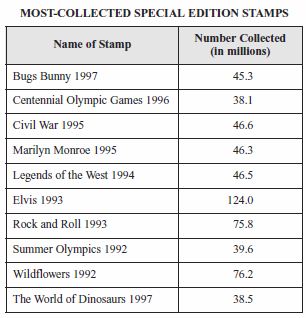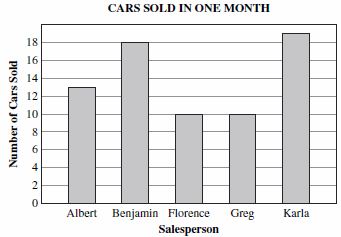Remarks
Students should make frequency tables for numerical or categorical data, grouping data in different ways to investigate how different groupings describe the data.
This is the first time in 2007 Florida mathematics standards that students are expected to use mean, median, mode, and range in a formal sense to describe a set of data.
-
Item Type(s):
This benchmark may be assessed using:
MC
,
GR
item(s)
- Clarification :
Students will determine the mean, median, mode, or range for a given set of data. - Content Limits :
Items may include data presented in a table, line plot, bar graph, double bar graph, or line graph.The number of data points may not exceed ten when the median or mode is being determined.
The number of data points may not exceed six when the mean is being calculated.
Items may include the use of frequency tables for numerical or categorical data.
Items may include the use of whole numbers; fractions with denominators of 2, 4, or 10; or decimal values, which may include 0.25, 0.75, or tenths.
- Stimulus Attributes :
Items should be set in a real-world context.
- Test Item #: Sample Item 1
- Question: The table below shows information about the 10 most-collected special edition stamps in the United States as of 1998.

For the stamps listed in the table, what is the median number collected, in millions?
- Difficulty: N/A
- Type: MC: Multiple Choice
- Test Item #: Sample Item 2
- Question: The bar graph below shows the number of cars sold by each of 5 car salespeople during the same month.

What is the mean number of cars sold during this month for these 5 salespeople?
- Difficulty: N/A
- Type: GR: Gridded-Response
Related Access Points
Related Resources
Lesson Plans
STEM Lessons - Model Eliciting Activity
The Gonzalez family is moving to Florida and they need our students' help deciding which neighborhood to live in. To help them, the students will calculate the mean and median of home prices in the neighborhood and trends in price changes.
Model Eliciting Activities, MEAs, are open-ended, interdisciplinary problem-solving activities that are meant to reveal students’ thinking about the concepts embedded in realistic situations. MEAs resemble engineering problems and encourage students to create solutions in the form of mathematical and scientific models. Students work in teams to apply their knowledge of science and mathematics to solve an open-ended problem while considering constraints and tradeoffs. Students integrate their ELA skills into MEAs as they are asked to clearly document their thought processes. MEAs follow a problem-based, student-centered approach to learning, where students are encouraged to grapple with the problem while the teacher acts as a facilitator. To learn more about MEAs visit: https://www.cpalms.org/cpalms/mea.aspx





